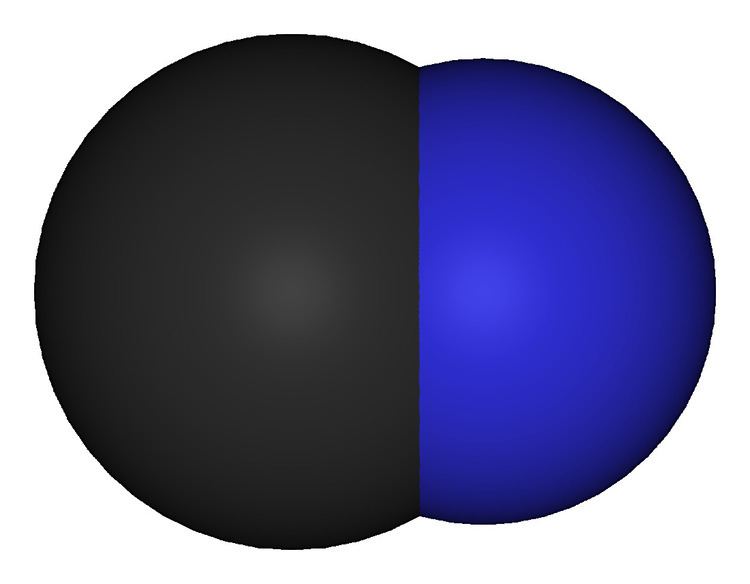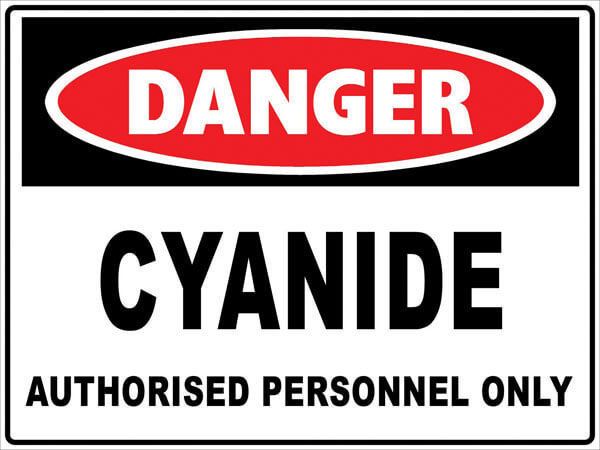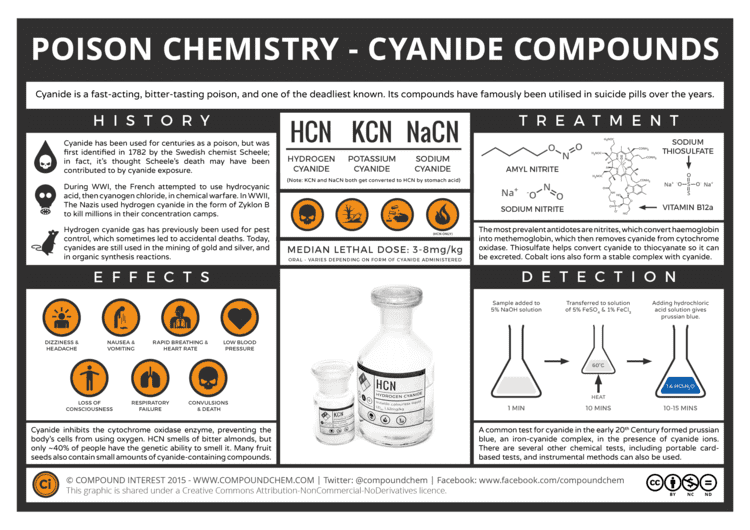Formula CN− | Molar mass 26.02 g/mol | |
 | ||
Compounds classified cyanide
A cyanide is any chemical compound that contains monovalent combining group CN. This group, known as the cyano group, consists of a carbon atom triple-bonded to a nitrogen atom.
Contents
- Compounds classified cyanide
- Cyanide poisoning death penalty execution
- Nomenclature and etymology
- In nature
- Interstellar medium
- Pyrolysis and combustion product
- Coordination chemistry
- Organic derivatives
- Manufacture
- Toxicity
- Antidote
- Sensitivity
- Mining
- Industrial organic chemistry
- Medical uses
- Illegal fishing and poaching
- Pest control
- Niche uses
- Human poisoning
- Food additive
- Prussian blue
- para Benzoquinone in DMSO
- Copper and an aromatic amine
- Pyridine barbituric acid colorimetry
- Corrinoids colorimetry
- Gas diffusion flow injection analysis amperometry
- References

In inorganic cyanides, such as sodium cyanide and potassium cyanide this group is present as the negatively charged polyatomic cyanide ion (CN−); these compounds, which are regarded as salts of hydrocyanic acid, are highly toxic. The cyanide ion is isoelectronic with carbon monoxide and with molecular nitrogen.

Organic cyanides are usually called nitriles; in these, the CN group is linked by a covalent bond to a carbon-containing group, such as methyl (CH3) in methyl cyanide (acetonitrile). Because they do not release cyanide ions, nitriles are generally less toxic, or in the case of insoluble polymers such as acrylic fiber, essentially nontoxic unless burned.

Hydrocyanic acid, also known as hydrogen cyanide, or HCN, is a highly volatile liquid used to prepare acrylonitrile, which is used in the production of acrylic fibers, synthetic rubber, and plastics. Cyanides are employed in a number of chemical processes, including fumigation, case hardening of iron and steel, electroplating, and the concentration of ores. In nature, substances yielding cyanide are present in certain seeds, such as the pit of the cherry and the seeds of apples.

Cyanide poisoning death penalty execution
Nomenclature and etymology

In IUPAC nomenclature, organic compounds that have a –C≡N functional group are called nitriles. Thus, nitriles are organic compounds. An example of a nitrile is CH3CN, acetonitrile, also known as methyl cyanide. Nitriles usually do not release cyanide ions. A functional group with a hydroxyl and cyanide bonded to the same carbon is called cyanohydrin. Unlike nitriles, cyanohydridins do release hydrogen cyanide. In inorganic chemistry, salts containing the C≡N− ion are referred to as cyanides.

The word is derived from the Greek kyanos, meaning dark blue, as a result of its being first obtained by the heating of the pigment known as Prussian blue.
In nature
Cyanides are produced by certain bacteria, fungi, and algae and are found in a number of plants. Cyanides are found in substantial amounts in certain seeds and fruit stones, e.g., those of apricots, apples, and peaches. In plants, cyanides are usually bound to sugar molecules in the form of cyanogenic glycosides and defend the plant against herbivores. Cassava roots (also called manioc), an important potato-like food grown in tropical countries (and the base from which tapioca is made), also contain cyanogenic glycosides.
The Madagascar bamboo Cathariostachys madagascariensis produces cyanide as a deterrent to grazing. In response, the golden bamboo lemur, which eats the bamboo, has developed a high tolerance to cyanide.
Interstellar medium
The cyanide radical CN· has been identified in interstellar space. The cyanide radical (called cyanogen) is used to measure the temperature of interstellar gas clouds.
Pyrolysis and combustion product
Hydrogen cyanide is produced by the combustion or pyrolysis of certain materials under oxygen-deficient conditions. For example, it can be detected in the exhaust of internal combustion engines and tobacco smoke. Certain plastics, especially those derived from acrylonitrile, release hydrogen cyanide when heated or burnt.
Coordination chemistry
The cyanide anion is a ligand for many transition metals. The high affinities of metals for this anion can be attributed to its negative charge, compactness, and ability to engage in π-bonding. Well-known complexes include:
Among the most important cyanide coordination compounds are the octahedrally coordinated compounds potassium ferrocyanide and the pigment Prussian blue, which are both essentially nontoxic due to the tight binding of the cyanides to a central iron atom. Prussian blue was first accidentally made around 1706, by heating substances containing iron and carbon and nitrogen, and other cyanides made subsequently (and named after it). Among its many uses, Prussian blue gives the blue color to blueprints, bluing, and cyanotypes.
The enzymes called hydrogenases contain cyanide ligands attached to iron in their active sites. The biosynthesis of cyanide in the [NiFe]-hydrogenases proceeds from carbamoyl phosphate, which converts to cysteinyl thiocyanate, the CN− donor.
Organic derivatives
Because of the cyanide anion's high nucleophilicity, cyano groups are readily introduced into organic molecules by displacement of a halide group (e.g., the chloride on methyl chloride). In general, organic cyanides are called nitriles. Thus, CH3CN can be called methyl cyanide but more commonly is referred to as acetonitrile. In organic synthesis, cyanide is a C-1 synthon; i.e., it can be used to lengthen a carbon chain by one, while retaining the ability to be functionalized.
RX + CN− → RCN + X− (nucleophilic substitution) followed by- RCN + 2 H2O → RCOOH + NH3 (hydrolysis under reflux with mineral acid catalyst), or
- 2 RCN + LiAlH4 + (second step) 4 H2O → 2 RCH2NH2 + LiAl(OH)4 (under reflux in dry ether, followed by addition of H2O)
Manufacture
The principal process used to manufacture cyanides is the Andrussow process in which gaseous hydrogen cyanide is produced from methane and ammonia in the presence of oxygen and a platinum catalyst.
2 CH4 + 2 NH3 + 3 O2 → 2 HCN + 6 H2OGaseous hydrogen cyanide may be dissolved in aqueous sodium hydroxide solution to produce sodium cyanide.
Toxicity
Many cyanides are highly toxic. The cyanide anion is an inhibitor of the enzyme cytochrome c oxidase (also known as aa3) in the fourth complex of the electron transport chain (found in the membrane of the mitochondria of eukaryotic cells). It attaches to the iron within this protein. The binding of cyanide to this enzyme prevents transport of electrons from cytochrome c to oxygen. As a result, the electron transport chain is disrupted, meaning that the cell can no longer aerobically produce ATP for energy. Tissues that depend highly on aerobic respiration, such as the central nervous system and the heart, are particularly affected. This is an example of histotoxic hypoxia.
The most hazardous compound is hydrogen cyanide, which is a gas at ambient temperatures and pressure and can therefore be inhaled. For this reason, an air respirator supplied by an external oxygen source must be worn when working with hydrogen cyanide. Hydrogen cyanide is produced when a solution containing a labile cyanide is made acidic, because HCN is a weak acid. Alkaline solutions are safer to use because they do not evolve hydrogen cyanide gas. Hydrogen cyanide may be produced in the combustion of polyurethanes; for this reason, polyurethanes are not recommended for use in domestic and aircraft furniture. Oral ingestion of a small quantity of solid cyanide or a cyanide solution as little as 200 mg, or exposure to airborne cyanide of 270 ppm, is sufficient to cause death within minutes.
Organic nitriles do not readily release cyanide ions, and so have low toxicities. By contrast, compounds such as trimethylsilyl cyanide (CH3)3SiCN readily release HCN or the cyanide ion upon contact with water.
Antidote
Hydroxocobalamin reacts with cyanide to form cyanocobalamin, which can be safely eliminated by the kidneys. This method has the advantage of avoiding the formation of methemoglobin (see below). This antidote kit is sold under the brand name Cyanokit and was approved by the FDA in 2006.
An older cyanide antidote kit included administration of three substances: amyl nitrite pearls (administered by inhalation), sodium nitrite, and sodium thiosulfate. The goal of the antidote was to generate a large pool of ferric iron (Fe3+) to compete for cyanide with cytochrome a3 (so that cyanide will bind to the antidote rather than the enzyme). The nitrites oxidize hemoglobin to methemoglobin, which competes with cytochrome oxidase for the cyanide ion. Cyanmethemoglobin is formed and the cytochrome oxidase enzyme is restored. The major mechanism to remove the cyanide from the body is by enzymatic conversion to thiocyanate by the mitochondrial enzyme rhodanese. Thiocyanate is a relatively non-toxic molecule and is excreted by the kidneys. To accelerate this detoxification, sodium thiosulfate is administered to provide a sulfur donor for rhodanese, needed in order to produce thiocyanate.
Sensitivity
Minimum risk levels (MRLs) may not protect for delayed health effects or health effects acquired following repeated sublethal exposure, such as hypersensitivity, asthma, or bronchitis. MRLs may be revised after sufficient data accumulates.
Mining
Cyanide is mainly produced for the mining of gold and silver: It helps dissolve these metals and their ores. In the cyanide process, finely ground high-grade ore is mixed with the cyanide (concentration of about two kilogram NaCN per tonne); low-grade ores are stacked into heaps and sprayed with a cyanide solution (concentration of about one kilogram NaCN per ton). The precious metals are complexed by the cyanide anions to form soluble derivatives, e.g., [Au(CN)2]− and [Ag(CN)2]−.
Silver is less "noble" than gold and often occurs as the sulfide, in which case redox is not invoked (no O2 is required). Instead, a displacement reaction occurs:
The "pregnant liquor" containing these ions is separated from the solids, which are discarded to a tailing pond or spent heap, the recoverable gold having been removed. The metal is recovered from the "pregnant solution" by reduction with zinc dust or by adsorption onto activated carbon. This process can result in environmental and health problems. A number of environmental disasters have followed the overflow of tailing ponds at gold mines. Cyanide contamination of waterways has resulting in numerous cases of human and aquatic species mortality.
Aqueous cyanide is hydrolyzed rapidly, especially in sunlight. It can mobilize some heavy metals such as mercury if present. Gold can also be associated with arsenopyrite (FeAsS), which is similar to iron pyrite (fool's gold), wherein half of the sulfur atoms are replaced by arsenic. Gold-containing arsenopyrite ores are similarly reactive toward inorganic cyanide.
Cyanide is also used in electroplating, where it stabilizes metal ions in the electrolyte solution prior to their deposition.
Industrial organic chemistry
Some nitriles are produced on a large scale, e.g., adiponitrile is a precursor to nylon. Such compounds are often generated by combining hydrogen cyanide and alkenes, i.e., hydrocyanation: RCH=CH2 + HCN → RCH(CN)CH3. Metal catalysts are required for such reactions.
Medical uses
The cyanide compound sodium nitroprusside is used mainly in clinical chemistry to measure urine ketone bodies mainly as a follow-up to diabetic patients. On occasion, it is used in emergency medical situations to produce a rapid decrease in blood pressure in humans; it is also used as a vasodilator in vascular research. The cobalt in artificial vitamin B12 contains a cyanide ligand as an artifact of the purification process; this must be removed by the body before the vitamin molecule can be activated for biochemical use. During World War I, a copper cyanide compound was briefly used by Japanese physicians for the treatment of tuberculosis and leprosy.
Illegal fishing and poaching
Cyanides are illegally used to capture live fish near coral reefs for the aquarium and seafood markets. The practice is controversial, dangerous, and damaging but is driven by the lucrative exotic fish market.
Poachers in Africa have been known to use cyanide to poison waterholes, to kill elephants for their ivory.
Pest control
Cyanide is used for pest control in New Zealand particularly for possums, an introduced marsupial that threatens the conservation of native species and spreads tuberculosis amongst cattle. Possums can become bait shy but the use of pellets containing the cyanide reduces bait shyness. Cyanide has been known to kill native birds, including the endangered kiwi. Cyanide is also effective for controlling the dama wallaby, another introduced marsupial pest in New Zealand. A licence is required to store, handle and use cyanide in New Zealand.
Niche uses
Potassium ferrocyanide is used to achieve a blue color on cast bronze sculptures during the final finishing stage of the sculpture. On its own, it will produce a very dark shade of blue and is often mixed with other chemicals to achieve the desired tint and hue. It is applied using a torch and paint brush while wearing the standard safety equipment used for any patina application: rubber gloves, safety glasses, and a respirator. The actual amount of cyanide in the mixture varies according to the recipes used by each foundry.
Cyanide is also used in jewelry-making and certain kinds of photography such as sepia toning.
Cyanides are used as insecticides for fumigating ships. Cyanide salts are used for killing ants, and have in some places been used as rat poison (the less toxic poison arsenic is more common).
Although usually thought to be toxic, cyanide and cyanohydrins have been demonstrated to increase germination in various plant species.
Human poisoning
Deliberate cyanide poisoning of humans has occurred many times throughout history. For notable cyanide deaths, see Cyanide poisoning: Historical cases.
Most significantly, hydrogen cyanide released from pellets of Zyklon-B was used extensively in the systematic mass murders of the Holocaust, especially in extermination camps. Poisoning by hydrogen cyanide gas within a gas chamber (as a salt of hydrocyanic acid is dropped into a strong acid, usually sulfuric acid) is one method of executing a condemned prisoner as the condemned prisoner eventually breathes the lethal fumes.
Food additive
Due to the high stability of their complexation with iron, ferrocyanides (Sodium ferrocyanide E535, Potassium ferrocyanide E536, and Calcium ferrocyanide E538) do not decompose to lethal levels in the human body and are used in the food industry as, e.g., an anticaking agent in table salt.
Prussian blue
Iron(II) sulfate is added to a solution suspected of containing cyanide, such as the filtrate from the sodium fusion test. The resulting mixture is acidified with mineral acid. The formation of Prussian blue is a positive result for cyanide.
para-Benzoquinone in DMSO
A solution of para-benzoquinone in DMSO reacts with inorganic cyanide to form a cyanophenol, which is fluorescent. Illumination with a UV light gives a green/blue glow if the test is positive.
Copper and an aromatic amine
As used by fumigators to detect hydrogen cyanide, copper(II) salt and an aromatic amine such as benzidine is added to the sample; as an alternative to benzidine an alternative amine di-(4,4-bis-dimethylaminophenyl) methane can be used. A positive test gives a blue color. Copper(I) cyanide is poorly soluble. By sequestering the copper(I) the copper(II) is rendered a stronger oxidant. The copper, in a cyanide facilitated oxidation, converts the amine into a colored compound. The Nernst equation explains this process. Another good example of such chemistry is the way in which the saturated calomel reference electrode (SCE) works. The copper, in a cyanide-facilitated oxidation, converts the amine into a colored compound.
Pyridine-barbituric acid colorimetry
A sample containing inorganic cyanide is purged with air from a boiling acid solution into a basic absorber solution. The cyanide salt absorbed in the basic solution is buffered at pH 4.5 and then reacted with chlorine to form cyanogen chloride. The cyanogen chloride formed couples pyridine with barbituric acid to form a strongly colored red dye that is proportional to the cyanide concentration. This colorimetric method following distillation is the basis for most regulatory methods (for instance EPA 335.4) used to analyze cyanide in water, wastewater, and contaminated soils. Distillation followed by colorimetric methods, however, have been found to be prone to interferences from thiocyanate, nitrate, thiosulfate, sulfite, and sulfide that can result in both positive and negative bias. It has been recommended by the USEPA (MUR March 12, 2007) that samples containing these compounds be analyzed by Gas-Diffusion Flow Injection Analysis — Amperometry.
Corrinoids colorimetry
A solution of aquacyano-corrinoids, such as cobalamin or cobinamide, reacts with free cyanide in an aqueous sample. The binding of cyanide to the corrinoid cobalt center leads to a color change from orange to violet, allowing for semi-quantification by naked-eye. Precise quantification of the cyanide content is feasible by UV-vis spectroscopy. Absorption of the corrinoid on a solid phase, allows detection of cyanide even in colored samples, rendering this method appropriate for the analysis of cyanide in water, wastewater, blood, and food. Furthermore, this technology is non-toxic and considerably less prone to interference than the pyridine-barbituric acid colorimetry method.
Gas diffusion flow injection analysis — amperometry
Instead of distilling, the sample is injected into an acidic stream where the HCN formed is passed under a hydrophobic gas diffusion membrane that selectively allows only HCN to pass through. The HCN that passes through the membrane is absorbed into a basic carrier solution that transports the CN to an amperometric detector that accurately measures cyanide concentration with high sensitivity. Sample pretreatment determined by acid reagents, ligands, or preliminary UV irradiation allow cyanide speciation of free cyanide, available cyanide, and total cyanide respectively. The relative simplicity of these flow injection analysis methods limit the interference experienced by the high heat of distillation and also prove to be cost effective since time consuming distillations are not required.
